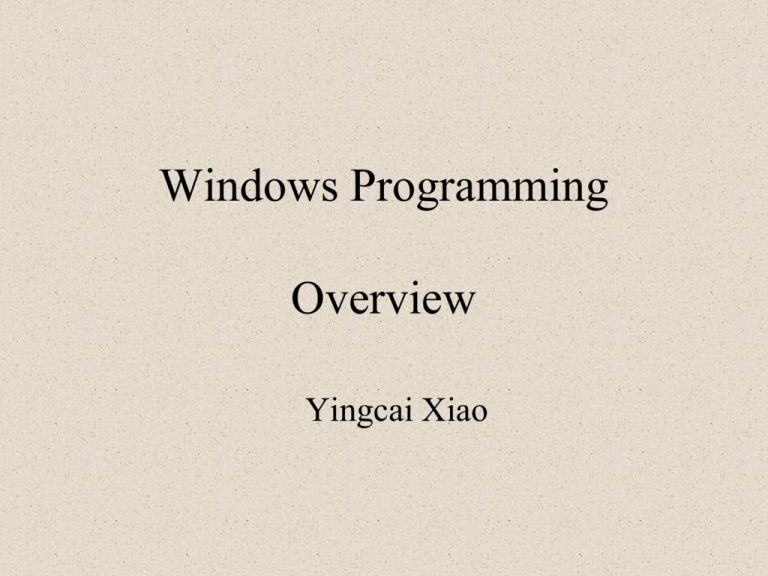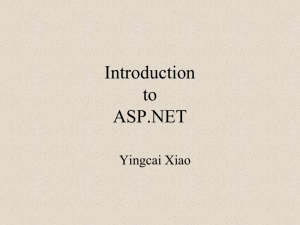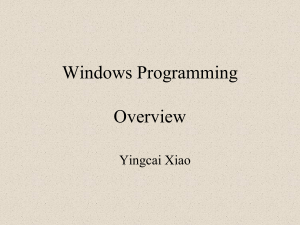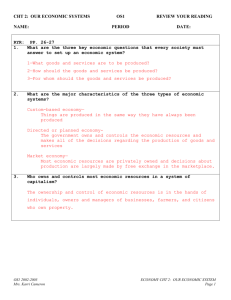
Windows Programming
Overview
Yingcai Xiao
What is a Computer?
From the Webster’s New World Dictionary:
1. A person who computes.
2. A device used for computing (an
electronic machine which by means of
stored instructions and information,
perform rapid, often complex calculations
or compiles, correlates, and selects data).
What is a program and what is programming?
Programs:
stored computer instructions for data
processing.
Programming
= Data Structures + Algorithms
Professor Donald E. Knuth
http://www-cs-faculty.stanford.edu/~knuth/
What is Windows Programming?
Windows Programming:
Programming for the Windows platform?
Programming on the Windows platform!
What Types of Programs?
Programs to be covered in this class:
(1) Windows:
CLI (Command Line Interface)
GUI (Graphical User Interface)
NUI (Natural User Interface)
(2) Web: Server Side, Web Applications,
3-Tir Enterprise Applications,
Web Services
(3) Cloud: Applications on the Cloud.
What Programming Tools? C# & .NET
C#:
(0) C^(+)^(2n); n = 0, 1, 2, => C, C++, C#
(1) The most advanced programming language to date
(3) OOP (Object-oriented Programming)
(4) EDP (Event Driven Programming)
(5) Dynamic type generation
(6) Platform-independent?: Code runs on any platform
with .NET runtime
(7) Visual Studio 2012
What is .NET?
.Net is a framework for developing
OS-platform-independent,
Programming-language-independent,
web-enabled,
distributed
applications.
Our Approach
• Principles and practices: know the concepts
and know how to design and implement an
application.
• Inside and Out: how does it work inside
(under the hood), how to design a system
(the big picture).
• Gradual: starting from the fundamentals
and add new features as we move ahead.
Textbooks and References
Textbooks:
Programming Microsoft .NET, Jeff Prosise, Microsoft Press
http://www.amazon.com/Programming-Microsoft%C2%AE-NET-Corereference/dp/0735613761
In Safari (free online read for UA students through VPN)
http://proquest.safaribooksonline.com/book/programming/microsoftdotnet/0735613761/firstchapter
Pro C# 5.0 and the .NET 4.5 Framework (Expert's Voice in .NET), Andrew Troelsen,
Apress
http://www.amazon.com/Pro-NET-Framework-Experts-Voice/dp/1430242337
http://proquest.safaribooksonline.com/book/programming/csharp/9781430242338
Textbooks and References
Reference Books:
Professional C# 4 and .NET 4, Christian Nagel, et. al., Wrox
Professional C#, Simon Robinson, et. al., Wrox
Microsoft .NET for Programmers, Fergal Grimes, Manning
Programming C#: Building .NET Applications with C#, Jesse Liberty, O’Reilly
For Beginners:
C# Concisely, Bishop & Horspool, Pearson / Addison Wesley
Beginning C# Objects from Concepts to Code, Barker and Palmer, Apress
Microsoft Visual C#.NET Step by Step, John Sharp, Microsoft Press
Visual C#2010, Deitel & Deitel
Understanding .NET, David Chappell, Pearson / Addison Wesley
System Support
Integrated Development Platform (IDE):
Microsoft Visual Studio 2010
From DreamSpark (free downloads)
The lab computers:
CAS 241 and 254
With Microsoft Visual Studio 2012
Server for the course:
winverv1.cs.uakron.edu
With Microsoft Visual Studio 2010
An Introduction
to
C# and .NET
From Source to Binary (C++)
Process
Coding
Products
.cpp
(implementations)
.h
(UDT definitions)
Purpose
.h contains definitions of all UDT(User
Defined Data Types):
struct , class , enum , templates, #define
(preprocessor directives) , encapsulation
Notes
Timer.h:
#define PI 3.14
class Timer {int t;
setTimer(int t);};
Timer.cpp
Timer::setTimer(int t){this.t=t;}
Preprocessing
.I
.pch
.ipch
.I = .cpp with the contents of all .h files added,
white spaces removed, preprocessor directives
resolved,
all PI's replaced with 3.14
.pch -> precompiled header (preprocessed
.pch is large (in MBs)
commonly used headers) ,
.ipch -> intellisense pch
Compilation
.obj
Resolve templates, check syntax, verify types, Syntax errors reported to the
generate machine/binary code.
programmer.
Linking
Loading
Running
Link all object files together, create
executables ,static libraries, dynamic linked
.exe .lib .dll
libraries (shared by all programs on the
system).
Load program into memory (RAM) :
process (in memory
stack->static (per PID); heap->dynamic (per
running program) /
system/resolved at run-time) ; text->binary
PID
code.
Point PC to the entry point in code: main;
Moving
execute instruction code one statement at a
PC
time.
(program counter)
Static linked lib and exe are large:
all machine code are copied in, no
sharing.
int i; // static on the stack
new int; // dynamic on the heap
setTimer // an address in the
code/text
PC jumps to setTimer when the
method is called; Return sets the
PC back to the caller.
Traditional Compilation (Linking)
Source Code for Language 1
Source Code for Language 1
Language 1 Compiler on OS1
Language 1 Compiler on OS2
Binary Code for OS1
Binary Code for OS2
OS1
OS2
Common Binary Code?
OS-Independent Code:
Intermediate Languages
The trend to support OS-independent binary
code is to compile the source code into the binary
format of an intermediate language.
And to provide an interpreter for the
intermediate language on each OS to translate the
binary code of the intermediate language into the
native binary code of the OS.
OS-Independent Compilation: Intermediate Language
Source Code for Language 1
Language 1 Compiler on OS1
Language 1 Compiler on OS2
Intermediate Binary Code
Intermediate Code Interpreter OS1
Intermediate Code Interpreter OS2
Binary Code for OS1
Binary Code for OS2
OS1
OS2
Java Intermediate Language: Java Bytecode
Java Source Code (.java)
Java Compiler (javac) on OS1
Java Compiler (javac) on OS2
Java Bytecode (.class)
Java Interpreter on OS1 (java)
Java Interpreter on OS2 (java)
Binary Code for OS1
Binary Code for OS2
OS1
OS2
Program statements are interpreted one at a time during the run-time.
JIT Compiler
An interpreter interprets intermediate code one
line at a time. Slow execution.
A JIT (Just-In-Time) Compiler compiles the
complete code all at once just into native binary
code before execution. Faster execution.
JIT Complier: Java Bytecode Compiler
Java Source Code (.java)
Java Compiler (javac) on OS1
Java Compiler (javac) on OS2
Java Bytecode (.class)
Java JIT Compiler on OS1
Java JIT Compiler on OS2
Binary Code for OS1
Binary Code for OS2
OS1
OS2
All programming statements are compiled at compile time.
MSIL: Microsoft Intermediate Language
Source Code for Language 1
Language 1 Compiler on OS1
Language 1 Compiler on OS2
MSIL Code
MSIL JIT Compiler on OS1
MSIL JIT Compiler on OS2
Binary Code for OS1
Binary Code for OS2
OS1
OS2
.NET OS-Platform-Independence
A Common Language?
.NET Common Language Runtime
To make .NET language independent, CLR (Common Language
Runtime) is defined as the runtime environment.
CLR defines CTS (Common Type System) which should be
followed by all languages to be used in the .NET framework.
Syntax: int, for, …, struct, class,
Semantics: multiple inheritance not allowed in CTS
Object Oriented: encapsulation, inheritance and polymorphism
Visual Basic (.Net) redesigned to be OO
The code that follows CTS standard is called managed code.
regular C++ supports multiple inheritance
managed C++ does not support multiple inheritance
CLR: Common Language Runtime
Source Code for Language 1
Source Code for Language 2
Language 1 Compiler on OS1
Language 2 Compiler on OS2
MSIL Code Confirming CTS (Managed Code)
CLR on OS1
CLR on OS2
Binary Code for OS1
Binary Code for OS2
OS1
OS2
.NET Language-Independence
.NET Architecture for Language and Platform Independence
(fan-in and fan-out on MSIL)
Source Code for Language 1
Source Code for Language 2
Language 1 Compiler on OS1
Language 2 Compiler on OS2
MSIL Code Confirming CTS (Managed Code)
CLR on OS1
CLR on OS2
Binary Code for OS1
Binary Code for OS2
OS1
OS2
CLI (Common Language Infrastructure)
CLR/CTS for Everyone?
CLI : Common Language Infrastructure
A specification defines an environment for multiple
high-level languages to be used on different computer
platforms.
Created by Microsoft based on .NET, standardized by
MS, Intel, HP and others, ratified by ECMA and ISO.
.NET is an implementation of CLI for desktop systems.
.NET Compact Framework is an implementation of CLI
for portable devices.
Open Source implementations: Mono development
platform (Novell), Portable .NET (dotGNU)
CLI (Common Language Infrastructure) Specification
Open Architecture for Language and Platform Independent Programming
Source Code for Language 1
Source Code for Language 2
Language 1 Compiler on OS1
Language 2 Compiler on OS2
CIL (Common Intermediate Language) Code
Confirming CTS (Common Type System)
CLR for OS1
CLR for OS2
Binary Code for OS1
Binary Code for OS2
OS1
OS2
Even though, CLI/CTS/CLR can make a program
written in any language to run on any platform, the
entire program (including all libraries used) has to be
on the platform before running.
Can we have part of a program on one computer and
another part of the same program on another
computer?
Distributed Computing. A program is divided into
multiple parts and different parts are distribute on
different computers.
e.g. virtual surgery.
Web Enabled & Distributed
.NET
.Net is Web-enabled and Distributed
To run distributed code on the web, we need a
standardized way to register and access the code.
Registration:
UDDI Registry: Universal Description,
Discovery, and Integration.
Access:
SOAP: Simple Object Access Protocol
WSDL: Web Service Description Language
A Common Language for the Internet
(free of compilation and translation)?
A Common Language for the Internet
•
•
•
•
Tim Berners-Lee, Director of WWW Consortium
CERN : Center for European Particle Research
ASCII text (ISO/IEC 8859-1) is platform-independent.
HTTP (Hyper Text Transport Protocol)
e.g.
GET wp.html
Assembly Language for the Internet
HTML (Hyper Text Markup Language)
High-level language for the Internet)
hyper text: text that describes other text
tags: type definition of text in text
<title>WP</title>
all tags are predefined in HTML
only system defined types, no user defined types
Recognizable by all types of computers. (World Wide Web)
A Common Language for the Internet
HTTP:
Communication protocol between client and server.
HTML:
Common language for the WWW
Interpreted by web browsers
HTML5:
<video>, <audio>, <canvas>, SVG, MathML
https://www.khronos.org/webgl/wiki/Tutorial
https://en.wikipedia.org/wiki/HTML5
https://www.w3.org/TR/html5/
A Common Language for the Internet
XML (eXtensible Markup Language)
Allow user defined tags (types)
SOAP (Simple Object Access Protocol)
Standards for defining objects for the Internet
Based on XML
WSDL (Web Service Description Language)
Standards for describing web services for the Internet
Based on XML
.NET Architecture for Web-based Distributed Computing
Client 1
UDDI Registry 2
SOAP
Client 2
Web Service 1
UDDI Registry 1
WSDL Interface 1
Web Service 2
WEB
SOAP
WSDL Interface 2
.NET Framework Composition
http://en.wikipedia.org/wiki/.NET_Framework
.NET Framework Compositions
Common Language Runtime (CLR ): provides
the runtime environment for MSIL code.
Framework Class Library (FCL) : provides
standard libraries for developing common .Net
applications.
.NET runtime environment comes with
Windows
.NET development environment comes with
Visual Studio
.NET Framework Compositions
Current versions: framework 4.0 and VS 2010
In the works: framework 4.5 and VS “2011” for
Windows 8.
ARM (Advanced RISC Machine) support in 4.5
on Windows 8 in addition to x86
SIMD (single instruction, multiple data), multi
and many core processors. Some support through
Direct3D. No support yet for SSE (Streaming
SIMD Extensions to x86)
.Net Framework Class Library
System
Windows
Web
Data
(Database)
Forms
(GUI)
UI
Services
Enterprise
Services
XML
String,
(Data
Description)
…
Connection
DataSet
XmlDocument
Language Integrated Query,
Windows Presentation Foundation,
Windows Communication Foundation, …
.NET Application Types
Web Services
Browser
Local
Distributed
Accessible
Applications
Applications
Remote
Applications
.Net Framework Class Library
Common Language Runtime
OS
Other
Applications
History: .Net & COM
MFC: Microsoft Foundation Class, code reuse
within an application (process)
COM: Component Object Model, code reuse
across applications (processes)
DCOM: Distributed COM, code reuse across
systems
COM+: Internet-based Enterprise COM, code
reuse across the Internet
.NET: COM+ 2.0, all COM+ services are
available in .NET, even those not in managed
code, interoperable with COM-based applications
.NET Enterprise Servers
Internet Information Services (IIS): web server
Commerce Server: e-commerce server
SQL Server: database server
Exchange Server: MS exchange services
Mobile Information Server: wireless server
Internet Security and Acceleration (ISA) Server:
firewall, proxy, …
BizTalk: B2B (Business-to-Business) server
Versions of .NET
.Net is evolving.
1.0: fundamentals
2.0: partial classes, profile object, ACL
http://forums.asp.net/t/1115522.aspx
3.0: WCF (Windows Communication Foundation),
WWF (Windows Workflow Foundation, WPF (Windows
Presentation Foundation), Windows CardSpace
http://forums.asp.net/t/1115522.aspx
4.0: DLR (Dynamic Language Runtime), improved
security model,
http://msdn.microsoft.com/enus/library/ms171868.aspx
Versions of .NET
http://en.wikipedia.org/wiki/.N
ET_Framework#mediaviewer/
File:DotNet.svg
Summary
•
•
•
•
•
•
•
•
Computer
Programming
Windows Programming Tools
Source Code => Binary Code
Cross-platform Binary Code Reuse (CIL, CLR)
Distributed Computing
WWW/HTML5
.NET Components and Versions







